A Japanese community began forming in Vancouver in the 1880s and ‘90s, in part due to the modernization period in Japan that opened it up to Western trade and influence. Young Japanese men began leaving their homes to seek adventure or to find work and a better life. One of the many places along the west coast of Canada and the US they came to was Vancouver. Because many were employed at Vancouver’s Hastings Mill along the south shore of Burrard Inlet, the community formed along the waterfront and Powell Street became the main hub.
The earliest Christian mission activity among the Japanese community in Vancouver came from within the community itself. What grew into the Japanese Methodist Mission began in 1892.
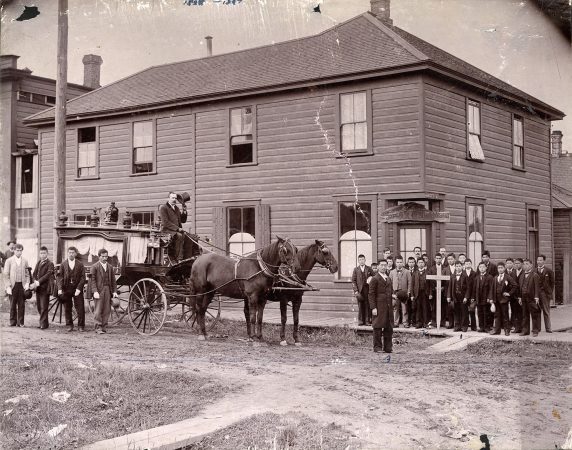
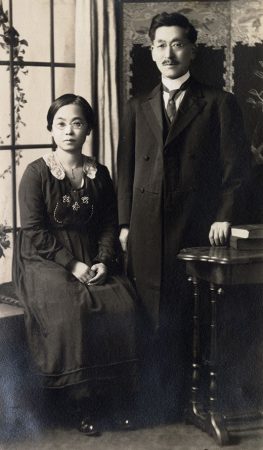
Mr. Tamura had been attending Homer Street Methodist Church and was interested in the spiritual well-being of Japanese Canadians.[2] He rented a house at Hastings and Main Streets and began an English language class. From this base, he organized a group known (in English) as both the “Mutual Encouragement Group” or the “Vancouver Japanese Christian Endeavour Association.” The group was made up of young people who met for prayer, study and discussion on the weekends. It had a close relationship with Homer Street Methodist Church.[3] Eventually the group outgrew its space and moved to a rented room on the corner of Abbott and Pender Streets. Leadership and expenses were largely donated.
By 1896, the community called its first ordained minister, the Rev. Goro Kaburagi, a young minister who had recently been ordained by the Methodist Episcopal Church in Columbus, Ohio. On Rev. Kaburagi’s initiative, the community sought admittance to the Methodist Church of Canada, and the former Vancouver Japanese Christian Endeavour Association became the Vancouver Japanese Mission of the Methodist Church, under the auspices of the General Board of Missions.[4] With funds from the national church, the congregation was able to purchase land and a house at 400 Powell Street.
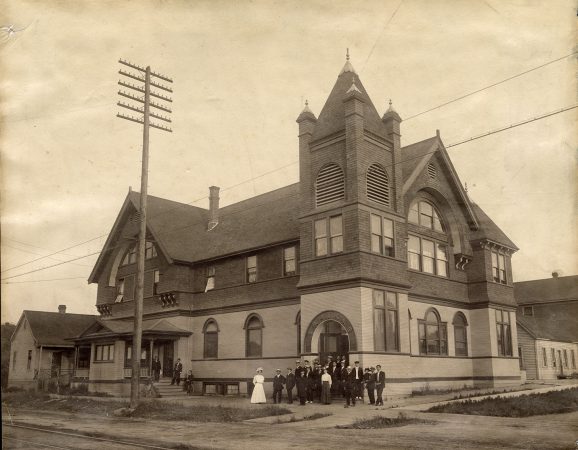
1893-1895 Rev. Okamoto
1896-1906 Rev. Goro Kaburagi
1906-1907 Rev. Zentaro Ono
1908-1914 Rev. Keijiro Kanazawa
1914-1917 Rev. Fumio Matsunaga
1917-1924 Rev. Yoshimitsu Akagawa
1924-1926 Rev. Yoshinosuke Yoshioka
1925-1942 Rev. Dr. Kosaburo Shimizu
1942 Rev. Takashi Komiyama
An article in The Missionary Outlook (1907), describes the interior of the new mission building:
“On the ground floor is the hall where the church services, etc., are held, and which has seating accommodation for about 300 persons. Behind this are the large class rooms, one fitted with desks for day and night schools, the other is used for a kindergarten room and gymnasium… In the upper story are the dining-room, sitting-room, library and reading room, pastor’s study, kitchen, and thirteen bedrooms, with ample accommodation for two boys in each.”[5]
The church building became a landmark in the Japanese community, an important source of community education, a comforting presence.[6] It also became an agent of assimilation and enculturation into the predominantly Caucasian Canadian society.

More women and children began arriving during the early part of the 1900s. Hardworking members of the community brought prosperity, despite the challenges of discrimination and lower wages. By 1912, there were rooming houses, hotels, shops, a department store, and a large commercial building. [7]
The church building became a landmark in the Japanese community, an important source of community education, a comforting presence. It also became an agent of assimilation and enculturation into the predominantly Caucasian Canadian society.
Across Jackson Avenue from the church were the Powell Street Grounds, now known as Oppenheimer Park. The park was opened in 1898 and was a gathering place where sports and festivals took place. From about 1910 on, the Powell Street Church’s kindergarten used it as a playground, and teachers often taught English through playground games. From 1914 to 1942, it was home to the famed Vancouver Asahi baseball team; baseball teams from across the Lower Mainland would come to the park to test their mettle against the formidable Japanese players.
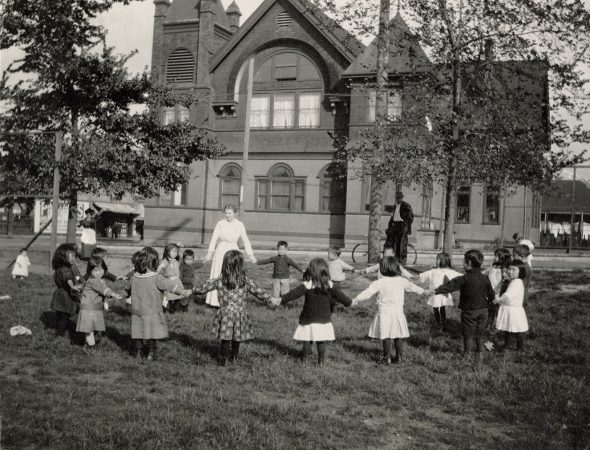
The Buddhist temple had been built in 1904 and was situated on Alexander Street. A new temple was constructed in 1933 but was seized by the government at the start of the Second World War. The Vancouver Buddhist Temple eventually bought the Powell Street Church property (1955) and used the original building until it was replaced in 1979.
[7] See Vancouver Hertiage Foundation Map Guides.The Powell Street Church built a gymnasium in 1920; it stood immediately adjacent to the church and in place of what had been the English night school residence. The building covered 2800 square feet and cost approximately $25,000 to build. It was known as “The Taiikukan”.

1901: Rev. Goro Kaburagi started an elementary school for Japanese children in the church, covering all subjects in both English and Japanese.[9] The school continued until 1906, when a community-sponsored Japanese Language School was opened at 439 Alexander Street.
1903: Rev. Kaburagi bought a printing press and began publishing a daily newspaper Canadian News—for both religious and secular news.
1908: The Methodist Woman’s Missionary Society (WMS) assigned a worker to the Mission, Miss A.E. Preston.
1909: The WMS purchased a house at 652 Keefer Street, Vancouver, to serve as their missionary residence.
ca. 1910: Sunday school began.

1915: Rev. Smith Stanley Osterhout was appointed “Superintendent of Oriental Missions” for BC by the Methodist Church. He became a strong presence and support in the life of the Powell Street congregation.
1919-1920: The congregation constructed and opened a gymnasium beside the church, offering use of the facility to the Japanese community at large.
“What I remember is that the adults, including my father, always went to meet the ship that brought people from Japan into Vancouver… and [would] bring the people to the church and get them all settled down—find jobs, places to live, things like that. And many of them then came to church and eventually became members of the United Church.”
Pastor George Takashima, who attended the Powell Street Church as a child
1924-1925: Began cooperative work with the Anglican Church, e.g. Vancouver Japanese Christian Church Conference, Nov. 1924 and Christian education leadership training meeting, 1925.
1925: The congregation entered church union with Presbyterian and Congregational churches, becoming the Japanese United Church (essentially a name change).

1928: Started a Young People’s Society.
1928: Opened a new congregation in the Fairview neighbourhood, with regular church services and a large Sunday school.
1928: Began publishing a Japanese-language newsletter, The Shepherd’s Call, which ran until 1942.

1932: Opened a free medical clinic for the Japanese community, initially to fight tuberculosis.
1933: Opened a welfare depot for those Japanese families hit hardest by the Great Depression.
1934: Kuichi Nomoto, the congregation’s first candidate for the ministry, was ordained by BC Conference. He graduated from Union College with the Chown Gold Medal in Divinity.

1936: The congregation became self-supporting. The 1937 year book indicates that the Powell Street Church was home to 268 families, and that 1100 persons were under pastoral oversight.
1936: Started the Junior Church for second-generation, or “Nisei”, congregants. The Junior Church met regularly every first and third Sunday of each month.
1941: The Sunday school had 274 pupils and 24 teachers.

A brilliant leader who cared for his flock in their time of need

Kosaburo Shimizu was born in the village of Tsuchida in Shiga Prefecture, Japan, in 1893. He came to Vancouver in 1907 as a young teenager and attended English night school at the Powell Street Church, living in one of the dormitories on the upper floor. A highly motivated student, he completed the full public school curriculum in English, working his way from elementary school to high school in seven years, all the while working as a “houseboy” (as the position was then called) with a family in New Westminster.
He began attending the Japanese Methodist Church in New Westminster and was baptized into the Christian church in 1913. While attending the University of British Columbia (1915-1919), he served as principal of the English night school at the Powell Street Church, where he also lived. During that time, he became close friends with Dr. Kozo Shimotakahara (who had just graduated from medical school).

Having earned a Bachelor of Arts degree, Kosaburo Shimizu felt a pull to a ministry in the Methodist Church. He was able to gain experience and earn money as a lay preacher in several BC communities — but one more adventure called to him before he was ready to enter full-time ministry. From 1922 to 1924, he pursued further studies in Boston and New York, graduating from Harvard University with a Master of Arts degree.[10] Even before he returned to BC, the Board of Home Missions asked him to work with the relatively new Japanese mission in Ocean Falls. He served there for two years while pursuing theological studies through correspondence.
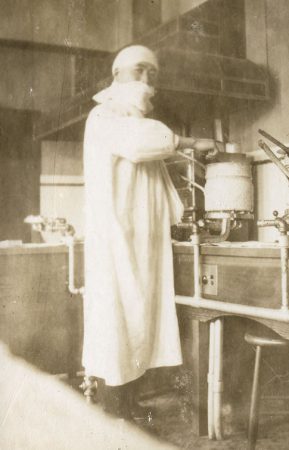
In his earlier years as principal of the Powell Street Church’s night school, the Vancouver congregation had become like family to him. So when their minister, Rev. Yoshinosuke Yoshioka, left for Toronto in 1926, the congregation was unanimous in its request for Rev. Shimizu to succeed him. The Board of Home Missions appointed him to the Powell Street Mission in September of 1926.
Rev. Shimizu was granted a special ordination on the request of the official board of the Powell Street Mission and the principal of Union College (the original United Church theological college in Vancouver, succeeded by VST). By this time, the Methodist Church had united with the Presbyterian, Congregational and Indigenous churches to form The United Church of Canada. Thus, Rev. Shimizu was ordained in 1927 by the British Columbia Conference of the United Church, even before finishing his theological degree.[11] He completed the degree requirements at Union College in 1929 and was awarded two academic prizes — only because the college had a by-law that did not allow more than two prizes to be awarded to any one student.[12]

During the depression, Rev. Shimizu led the congregation in starting a relief department in 1933 — which, while it demonstrated great compassion, was met with opposition, for cultural reasons, from the Vancouver Japanese community (appearing needy would have been challenging to the Japanese sense of dignity). With his friend Dr. Shimotakahara, Rev. Shimizu led the community in setting up the Vancouver Japanese Clinic, in partnership with the Vancouver Health Department, in 1932 and served as chair of the clinic.

During the Second World War, the United Church understood that the BC Security Commission would be sending people to internment camps according to their denomination. The Powell Street congregation expected to be sent to Kaslo, together as a group. In May 1942, Rev. Shimizu and his family moved to Kaslo. In the end, however, the Security Commission did not send people to the camps according to their denomination and Rev. Shimizu’s Vancouver flock was scattered.
During the summer of 1943, when the federal government’s policy was to resettle people of Japanese descent into the general population in eastern Canada, Rev. Shimizu visited some of the major resettlement sites in Ontario and Montreal. He dedicated significant time and effort to the resettlement of Japanese Canadians in the East, laying the foundation for their acceptance and employment. He achieved this through cooperation with the Federal Department of Labour, the YMCA and YWCA, the United Church Board of Home Missions and other organizations.

Rev. S.S. Osterhout, Superintendent of Oriental Missions, reported to Vancouver Presbytery in 1929:
“Additional to the usual activities carried on by the average mission church, our Japanese missions maintain at their own expense a very interesting department known as the Night School. Usually a superintending teacher or principal of the school is employed from the fees collected while a staff of volunteer teachers, men and women from the city churches, do the great bulk of the teaching. It is primarily an English language school carried on for five days of the week with time devoted during each evening session to an exhortation or address on some phase of the Christian religion. The average attendance at Powell Street is about seventy-five, Columbia Ave. thirty, and Steveston twenty-five. These schools in most cases constitute the first avenue of approach to the Christian Church and many of our adult baptisms are recruited from this source.”[14]

